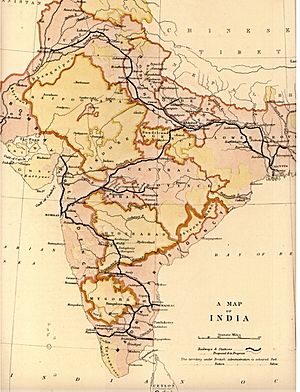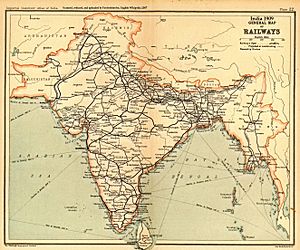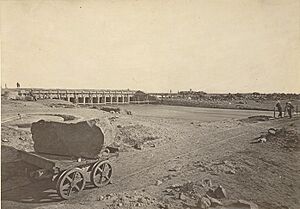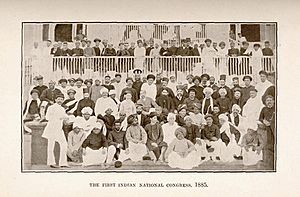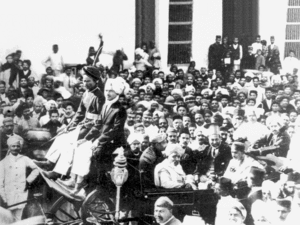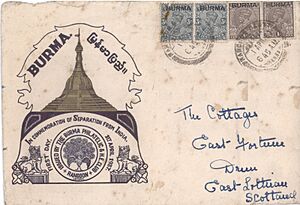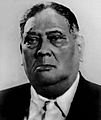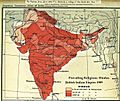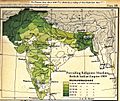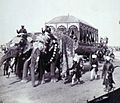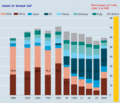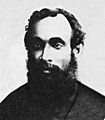British Raj facts for kids
Quick facts for kids
Indian Empire
|
|||||||||||||
|---|---|---|---|---|---|---|---|---|---|---|---|---|---|
| 1858–1947 | |||||||||||||
|
Anthem: "God Save the King/Queen"
|
|||||||||||||

1909 Map of the British Indian Empire, showing British India in two shades of pink and the princely states in yellow.
|
|||||||||||||
| Status | Imperial political structure (British India, a quasi-federation of presidencies and provinces directly governed by the British Crown through the Viceroy and Governor-General of India, Princely States, governed by Indian rulers, under the suzerainty of The British Crown exercised through the Viceroy of India) | ||||||||||||
| Capital | Calcutta (1858–1911) New Delhi (1911–1947) |
||||||||||||
| Common languages |
|
||||||||||||
| Religion | Hinduism, Islam, Christianity, Sikhism, Buddhism, Jainism, Zoroastrianism, Judaism | ||||||||||||
| Government | British Colonial Government | ||||||||||||
| Monarch of the United Kingdom and Emperor/Empressa | |||||||||||||
|
• 1858–1901
|
Victoria | ||||||||||||
|
• 1901–1910
|
Edward VII | ||||||||||||
|
• 1910–1936
|
George V | ||||||||||||
| Viceroyb | |||||||||||||
|
• 1858–1862
|
The 2nd Viscount Canning (first) | ||||||||||||
|
• 1947
|
The 1st Viscount Mountbatten (last) | ||||||||||||
| Secretary of State | |||||||||||||
|
• 1858–1859
|
Lord Stanley (first) | ||||||||||||
|
• 1947
|
The 5th Earl of Listowel (last) | ||||||||||||
| Legislature | Imperial Legislative Council | ||||||||||||
| History | |||||||||||||
| 23 June 1757 & 10 May 1857 | |||||||||||||
| 2 August 1858 | |||||||||||||
| 18 July 1947 | |||||||||||||
| 14 and 15 August 1947 | |||||||||||||
| Currency | Indian rupee | ||||||||||||
| ISO 3166 code | IN | ||||||||||||
|
|||||||||||||
|
|||||||||||||
The British Raj was a time when the British Empire ruled over a large part of the Indian subcontinent. "Raj" is a Hindi word meaning "rule," so "British Raj" means "British rule." This period lasted from 1858 to 1947.
During the British Raj, the British controlled areas that are now part of several countries. These include India, Pakistan, Bangladesh, Sri Lanka (then called Ceylon), and Myanmar (then called Burma). All these areas together were known as the British Indian Empire.
The British Raj included two main types of areas. First, there was British India, which was directly governed by the British. Second, there were many "princely states." These states had their own Indian rulers, but they were still under the overall authority of the British Crown.
The term "Undivided India" is sometimes used to describe the entire area under British rule. However, this term usually does not include Burma, which became a separate British colony in 1937. Other places like Aden and Singapore were also governed by India for some time.
British rule in India ended on August 15, 1947. This led to the creation of two new independent countries: India and Pakistan. Later, Bangladesh was formed from part of Pakistan. The division of the Indian Empire, known as the Partition of India, caused many people to move and led to much conflict.
Contents
How the British Raj Began
The British Raj officially began in 1858. Before this, a powerful trading company called the East India Company had controlled many parts of India. The company had its own army and ruled like a government.
The Indian Rebellion of 1857
In 1857, a major uprising happened across India. This event is often called the Indian Rebellion of 1857. It was a big challenge to the East India Company's rule.
After the rebellion, the British government decided to take direct control. The Government of India Act 1858 was passed. This act transferred the power from the East India Company directly to the British Crown.
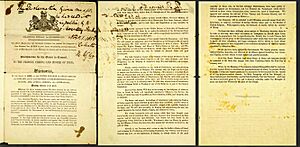
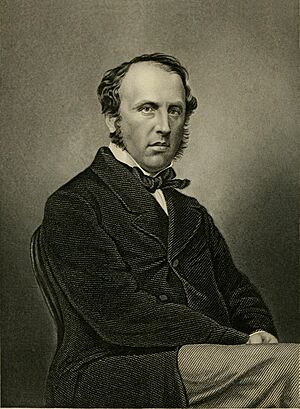
Queen Victoria became the Empress of India in 1876. The British monarch was the head of the Indian Empire. A special official called the Viceroy was appointed to rule India on behalf of the British Crown. The first Viceroy was Lord Canning.
Life Under British Rule
Life during the British Raj was very different for different people. The British built many new things in India, like railways and canals.
Building New Infrastructure
The British built a large railway network across India. By 1909, it was the fourth largest in the world. These railways helped move goods and people. They also built canals, like the Agra canal, to help with irrigation and farming.
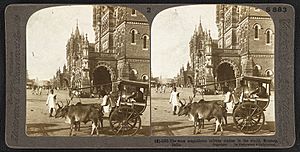
Many schools and universities were also established. The University of Calcutta, founded in 1857, is one of the oldest modern universities in India.
Society and Population
The British Raj had a significant impact on Indian society. The population of British people in India was small compared to the Indian population. In 1861, there were about 125,945 English people in India. Most of these were soldiers.
The Indian Army was very large. In 1880, it had 66,000 British soldiers and 130,000 Indian soldiers. The princely states also had their own armies, with about 350,000 soldiers.
Religions like Hinduism, Islam, Christianity, Sikhism, Buddhism, Jainism, Zoroastrianism, and Judaism were all present in India. The British tried to manage the different religious groups.
Movement Towards Independence
Over time, many Indians began to demand more rights and eventually, independence.
Early Nationalist Movements
Indian leaders started organizations to voice their concerns. The Indian National Congress was formed in 1885. It aimed to give Indians a greater say in their own government.
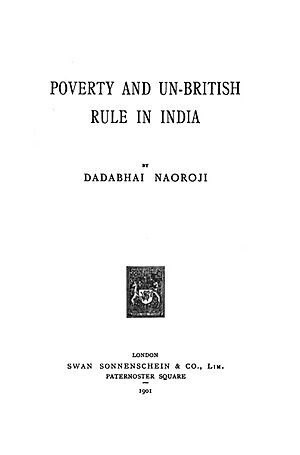
Leaders like Dadabhai Naoroji wrote about the economic impact of British rule. His book, Poverty and the Un-British Rule in India, highlighted how British policies affected India's wealth.
Key Figures and Events
Many important figures played a role in the independence movement.
- Mahatma Gandhi: He returned to India in 1915 and became a key leader. He promoted non-violent resistance, like the non-cooperation movement.
- Muhammad Ali Jinnah: A leader of the All-India Muslim League, he worked for the rights of Muslims in India.
- Annie Besant: She founded the Indian Home Rule League, pushing for self-government.
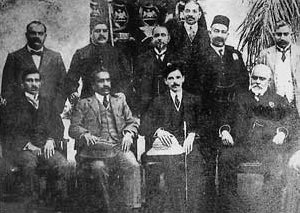
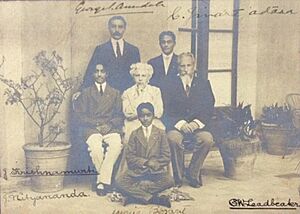
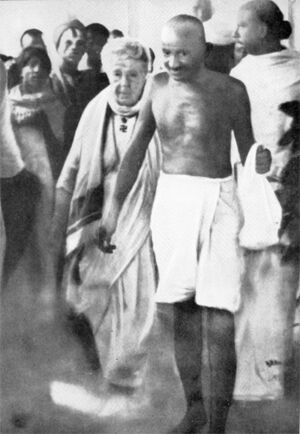
The British government made some reforms, like the Minto-Morley Reforms of 1909, which allowed for separate Muslim electorates. However, these changes were not enough for many Indians who wanted full independence.
End of the British Raj
After World War II, Britain decided to grant India independence.
The Partition of India
The process of independence was complex. There were strong disagreements between leaders of the Indian National Congress and the All-India Muslim League about the future of India. This led to the decision to divide British India into two separate countries: India and Pakistan.
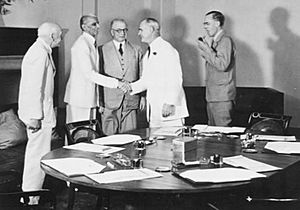
The Indian Independence Act was passed on July 18, 1947. British rule officially ended on August 15, 1947. The new boundaries between India and Pakistan were set on August 18.
The partition caused a huge movement of people and led to violence. Millions of people moved across the new borders.
Legacy of the Raj
The British Raj left a lasting impact on India. It influenced India's government, laws, education, and infrastructure. Even today, many aspects of modern India have roots in the British Raj period.
Images for kids
-
Sidney Rowlatt, the British judge under whose chairmanship the Rowlatt Committee recommended stricter anti-sedition laws
-
A. K. Fazlul Huq, known as the Sher-e-Bangla or Tiger of Bengal, was the first elected Premier of Bengal, leader of the K. P. P. and an important ally of the All India Muslim League.
-
Subhas Chandra Bose (second from left) with Heinrich Himmler (right), 1942
-
Sir Charles Wood (1800–1885) was President of the Board of Control of the East India Company from 1852 to 1855; he shaped British education policy in India, and was Secretary of State for India from 1859 to 1866.
-
Lord Salisbury was Secretary of State for India from 1874 to 1878.
-
Elephant Carriage of the Maharaja of Rewa, Delhi Durbar of 1903
-
One Mohur depicting Queen Victoria (1862)
-
The Queen's Own Madras Sappers and Miners, 1896
-
The University of Calcutta, established in 1857, is one of the three oldest modern state universities in India.
-
Lakshmibai, Rani of Jhansi, one of the principal leaders of the Great Uprising of 1857 who had lost her kingdom by the Doctrine of Lapse.
-
Sir Syed Ahmed Khan founder of the Muhammadan Anglo-Oriental College, wrote one of the early critiques, The Causes of the Indian Mutiny.
-
A 1887 souvenir portrait of Queen Victoria as Empress of India, 30 years after the Great Uprising.
-
Lord Ripon, the Liberal Viceroy of India, who instituted the Famine Code. 1880
-
Allan Octavian Hume (1829-1912), who proposed the idea of the Indian National Congress in a letter to graduates of Calcutta University.
-
Mehta, lawyer, businessman, and president of the sixth session of the Indian National Congress in 1890.
-
Lord Curzon, Viceroy of India, 1899–1905, who partitioned the Bengal Presidency in 1905.
-
Lord Minto, the viceroy who replaced Curzon in 1906. The Minto-Morley Reforms of 1909 allowed separate Muslim electorates.
-
Hakim Ajmal Khan, a founder of the Muslim League, was to also become the president of the Indian National Congress in 1921.
-
Khudadad Khan, the first Indian to be awarded the Victoria Cross, hailed from Chakwal District, Punjab (present-day Pakistan)
-
Hindus and Muslims, with flags of Indian National Congress and the Muslim League, collecting clothes to be burnt as a part of the non-cooperation movement
-
Staff and students, National College, Lahore, founded in 1921 by Lala Lajpat Rai after the non-co-operation movement. Standing, fourth from right is Bhagat Singh.
-
British prime minister, Ramsay MacDonald, three places to the right of Gandhi (to the viewer's left) at the 2nd Round Table Conference. Samuel Hoare is two places to Gandhi's right. Foreground, fourth from left, is B. R. Ambedkar representing the "Depressed Classes"
-
A second-day cancellation of the series "Inauguration of New Delhi", 27 February 1931, commemorating the new city designed by Sir Edwin Lutyens and Sir Herbert Baker
See also
 In Spanish: Raj británico para niños
In Spanish: Raj británico para niños


